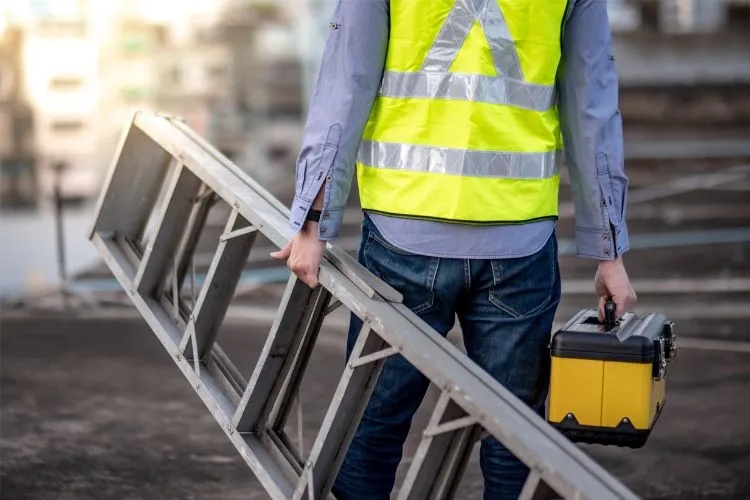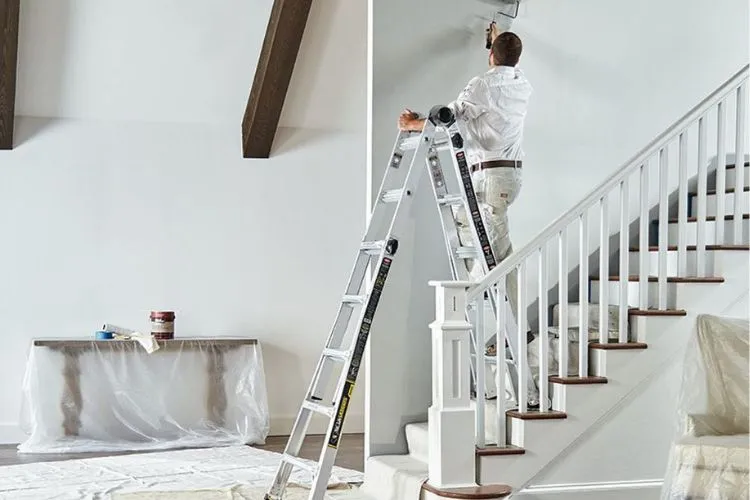Selecting the right ladder for a job isn’t just about reaching high places—it’s about ensuring your safety while you get there.
With various tasks demanding different ladder features, understanding how are ladders classified can save lives and enhance job performance.
Let’s delve into the world of ladders, exploring their classifications by design, material, and duty rating.
By the end of this article, you’ll be equipped to choose the perfect ladder for any task at hand.

Understanding Ladder Classification
Classification plays a pivotal role in ladder selection. It helps users identify which ladder is suitable for their specific needs, taking into account the task’s nature, the height required, and safety standards. Each class brings a set of features tailored to different jobs, ensuring users can work efficiently and safely.
How Are Ladders Classified? An Honest Guide
By Design
- Step Ladders: Step ladders are a staple in both home and professional settings. With their self-supporting A-frame design, they’re ideal for tasks that don’t require excessive heights, like changing light bulbs or reaching high shelves indoors.
- Extension Ladders: For tasks that demand height, such as painting a two-story building or cleaning gutters, extension ladders are the go-to choice. These ladders can extend to several times their storage length, offering flexibility and reach for outdoor projects.
- Telescopic Ladders: When storage space is at a premium, telescopic ladders shine. They can collapse to a fraction of their extended size, making them easy to transport and store. This adjustability also allows for precise height tuning, catering to varied job requirements.
- Multi-Purpose Ladders: The Swiss Army knife of ladders, multi-purpose models can function as step, extension, or scaffold ladders. This adaptability makes them a cost-effective option for users needing a single ladder for a broad range of tasks.
- Platform Ladders: For jobs requiring prolonged standing, platform ladders offer a stable, comfortable foothold. The inclusion of a platform allows users to work hands-free, focusing on the task without worrying about balance.
By Material
- Aluminum Ladders: Aluminum ladders are celebrated for their lightweight and rust-resistant properties. This combination makes them easy to move and durable, suitable for a wide range of tasks. However, they should not be used for electrical work due to their conductivity.
- Fiberglass Ladders: For electrical jobs, fiberglass ladders are the safest option. Their non-conductive nature protects users from electric shocks. While heavier than aluminum, their safety features and durability make them a favorite in the trade industry.
- Wooden Ladders: Wooden ladders offer a classic touch, providing good insulation from electricity. Yet, they require more maintenance than their metal counterparts, as wood can rot or warp over time.
By Duty Rating
Duty rating defines a ladder’s safe load capacity, including the weight of the user plus materials. These ratings are crucial for safety, ensuring ladders are used within their designed limits. Ratings range from heavy-duty (Type IAA) for industrial applications to light-duty (Type III) for household tasks.
Key Considerations When Choosing a Ladder
Selecting the right ladder involves more than just height and design. Consider the environment where it will be used; for instance, choosing a non-conductive fiberglass ladder for electrical work.
Weight capacity, storage space, and material properties also play a vital role in the decision-making process.
Safety Guidelines for Ladder Use
Safety should always be the top priority when using ladders. Setting up on a firm, level base, maintaining three points of contact, and avoiding overreaching are fundamental practices.
Respecting these guidelines can prevent accidents and ensure a safe working environment.

Maintenance and Care Tips
Ladder maintenance is straightforward yet essential. Regular inspections can catch signs of wear or damage, while proper cleaning and storage extend the ladder’s lifespan. Keeping your ladder in good condition ensures it remains reliable and safe for every use.
Innovations in Ladder Design
Modern innovations have made ladders safer and more user-friendly. From lightweight materials to multi-purpose designs, the evolution of ladders continues to meet the demands of various tasks while prioritizing user safety and convenience.
Pro Tips
Opt for a higher duty rating if you’re unsure about the weight requirements. Avoid using aluminum ladders near electricity, and always inspect your ladder before use, even if it’s not used frequently. Remember, safety and the right tool for the job go hand in hand.
Exploring Specialized Ladders

Firefighter and Emergency Ladders
In the realm of high-stakes operations, firefighter and emergency ladders stand out for their robustness and versatility. Crafted for rapid deployment and extreme resilience, these ladders must withstand intense heat and heavy use.
Features like retractability and high-strength materials enable firefighters to carry them swiftly through narrow spaces, scale buildings, or execute rescues, proving crucial in life-saving moments.
Library and Rolling Ladders
The elegance of library and rolling ladders brings both aesthetic and functional appeal to serene spaces such as libraries, upscale stores, and expansive warehouses. Their smooth gliding mechanism allows easy access to high shelves without sacrificing safety or stability.
Designed to blend with their surroundings, these ladders offer a blend of charm and practicality, enhancing the utility of spaces dedicated to knowledge, retail, or storage, facilitating access while adding a touch of sophistication.
Frequently Asked Questions (FAQs)
How do I know which duty rating ladder I need?
Consider the weight of the user plus any materials or tools being used. When in doubt, choose a ladder with a higher duty rating for added safety.
Can a fiberglass ladder be used for all types of work?
Yes, fiberglass ladders are versatile and especially recommended for electrical work due to their non-conductive nature.
Why are aluminum ladders popular despite the availability of stronger materials?
Aluminum ladders offer a good balance between strength, weight, and resistance to corrosion, making them suitable for a wide range of tasks.
How often should I inspect my ladder for signs of wear and tear?
A regular inspection before each use is recommended to ensure the ladder’s safety and integrity.
Is it necessary to use a platform ladder for painting, or will a step ladder suffice?
A step ladder can suffice for quick tasks, but a platform ladder offers more comfort and stability for projects that require more time.
Conclusion:
Understanding ladder classification is more than an academic exercise—it’s a critical step in ensuring workplace and home safety. By considering design, material, and duty rating, you can select the ideal ladder for your specific needs.
Always remember, the right ladder not only makes the job easier but also keeps you safe.
Choosing the right ladder, adhering to safety guidelines, and proper maintenance are essential for ensuring safe and efficient task completion. Armed with this knowledge, you’re ready to select and care for your ladder, ensuring it serves you well in both safety and performance.


